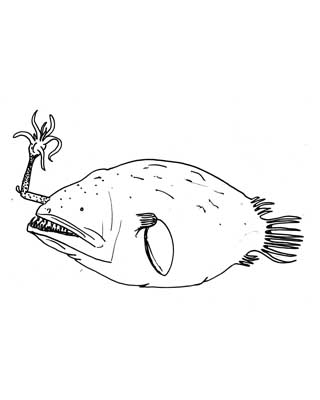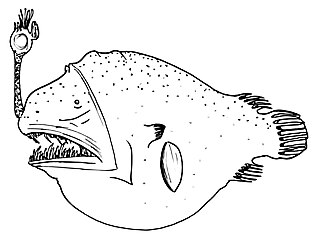
Ceratiidae, the warty sea devils, caruncled seadevils or seadevils, are a family of marine ray-finned fishes belonging to the suborder Ceratioidei, the deep-sea anglerfishes, in the anglerfish order Lophiiformes. The warty sea devils are sexually dimorphic with the small males being obligate sexual parasites of the much larger females. The fishes in this family are widely distributed from polar to tropical seas around the world.

Krøyer's deep sea angler fish, also known as the deep-sea angler, longray seadevil or northern seadevil, is a species of marine ray-finned fish belonging to the family Ceratiidae, the warty seadevils. It is found throughout the oceans of the world, from tropical to polar seas. It is the largest species in its family.

Oneirodidae, the dreamers are a family of marine ray-finned fishes belonging to the order Lophiiformes, the anglerfishes. These fishes are deepwater fishes found in the Atlantic, Indian and Pacific Oceans, and it is the most diverse family of fishes in the bathypelagic zone.
Thaumatichthyidae, the wolftrap anglers, is a small family of marine ray-finned fishes, also called the wolftrap seadevils, classified within the suborder Ceratioidei, the deep-sea anglerfishes. They have distinctive upper jaws with movable premaxillaries that can be lowered to form a cage-like trap around the much shorter lower jaw.

The horned lantern fish or prickly seadevil is a species of marine ray-finned fish, it is the only species in the monotypic family Centrophrynidae. This species has a circumglobal distribution and is distinguished from other deep-sea anglerfishes by various characters including four pectoral radials, an anterior spine on the subopercular bone, and a short hyoid (chin) barbel in both sexes.

Gigantactis is a genus of marine ray-finned fish belonging to the family Gigantactinidae, the whipnose anglers. The fishes in this genus have a circumglobal distribution in the deep waters of the tropical and temperate zones of the Atlantic, Indian and Pacific Oceans.
Lasiognathus intermedius is a species of marine ray-finned fish belonging to the family Thaumatichthyidae, the wolftrap anglers. This species is known from the deeper waters of the Atlantic and Pacific Oceans.

Black seadevils are small, deepsea lophiiform fishes of the family Melanocetidae. The five known species are all within the genus Melanocetus. They are found in tropical to temperate waters of the Atlantic, Indian, and Pacific Oceans, with one species known only from the Ross Sea.

Himantolophus groenlandicus, the Atlantic footballfish or Atlantic football-fish, is a species of marine ray-finned fish belonging to the family Himantolophidae, the footballfishes. This fish is found primarily in mesopelagic depths of the ocean. Despite its name, this species might not be restricted to the Atlantic Ocean, with its range possibly extending into the Indian Ocean and to the Pacific Ocean. It is found in tropical and temperate regions.
Chirophryne is a monospecific genus of marine ray-finned fish belonging to the family Oneirodidae, the dreamers, a family of deep sea anglerfishes. The only species in the gneus is Chirophryne xenolophus, the longhand dreamer. This species is known from a few locations in the Atlantic and Pacific Oceans.

The plainchin dreamarm is a species of marine ray-finned fish belonging to the family Oneirodidae, the dreamers, a family of deep sea anglerfishes. It is the only species in the monospecific genus Leptacanthichthys. This species occurs in the North Atlantic and North Pacific Oceans at depths down to 2,000 m (6,600 ft).
Lophodolos is a genus of marine ray-finned fish belonging to the family Oneirodidae, the dreamers, a family of deep sea anglerfishes. These predatory, deep-sea fishes are found in the tropical and subtropical oceans around the world.

Oneirodes is a genus of is a genus of marine ray-finned fish belonging to the family Oneirodidae, the dreamers, a family of deep sea anglerfishes. These predatory, deep-sea fishes are found around the world. This is the type genus, and the most speciose genus, of the family Oneirodidae. They are sexually dimorphic but, like most taxa within their family, the small males are free living and are not sexual parasites on the larger females. Only the females are used to identify the species in this genus as no species specific charaxcters have been found for males.

Pentherichthys is a monospecific genus of marine ray-finned fish belonging to the family Oneirodidae, the dreamers, a family of deep-sea anglerfishes. The only species in the genus is Pentherichthys atratus which is found in the bathypelagic zones of the tropical and subtropical Atlantic, Indian and Pacific Oceans. The males of this species are dwarfed and are not parasitic on the females.
Lasiognathus dinema is a species of marine ray-finned fish belonging to the family Thaumatichthyidae, the wolftrap anglers. This species is known only from the northern Gulf of Mexico.

Caulophryne jordani, the fanfin angler, is a species of marine ray-finned fish belonging to the family Caulophrynidae, the fanfins. This species is a deepwater species which is found in Oceanic waters around the world. Like other deepwater anglerfishes it shows extreme sexual dimorphism with the males being much smaller than the females and acting as sexual parasites of the females.

Chaenophryne draco, the smooth dreamer, or smooth-headed dreamer, is a species of marine ray-finned fish belonging to the family Oneirodidae, the dreamers, a family of deep-sea anglerfishes. This predatory, deep-sea fish is found in the tropical and subtropical oceans around the world. Like other deep-sea anglerfishes, it is sexually dimorphic, with the matamorphosed females dwarfing the metamorphosed males. The males are not sexual parasites.

Chaenophryne longiceps, the can-opener smoothdream, longhead dreamer or smooth-head dreamer, is a species of marine ray-finned fish belonging to the family Oneirodidae, the dreamers, a family of deep sea anglerfishes. This predatory, deep-sea fish is found in tropical and subtropical oceans around the world. Like other deep-sea anglerfishes, it is sexually dimorphic with the metamorphosed females dwarfing the metamorphosed males, though the males are not sexual parasites.
Oneirodes carlsbergi is a species of marine ray-finned fish belonging to the family Oneirodidae, the dreamers, a family of deep-sea anglerfishes. This fish is found mainly in the tropical eastern Atlantic and Pacific Oceans.
Oneirodes bradburyae is a species of marine ray-finned fish belongig to the family Oneirodidae, the dreamers, a family of deep-sea anglerfishes. This fish is known from a single specimen, the holotype which was collected in the Gulf of Mexico at 28°28'N, 87°18'W, the Oregon station 1028, from a depth between the surface and 780 fathoms. The species was described in 1956 by the American ichthyologist Marion Griswold Grey of the Field Museum of Natural History in Chicago. The holotype was a female with a standard length of 2.3 cm (0.91 in) and had a very long illicium, no incision on the upper posterior margin of the operculum. The specific name honours the American scientific illustrator and ichthyologist Margaret G. Bradbury, who worked at the Field Museum of Natural History and who illustrated Grey's description.














